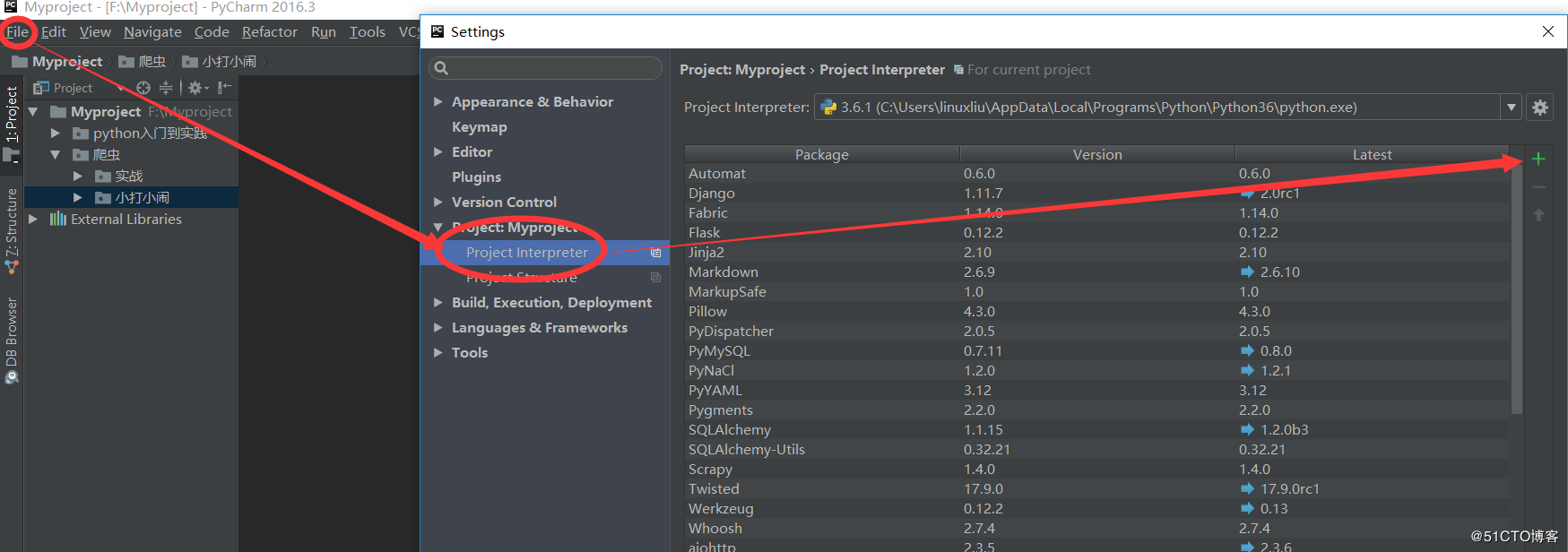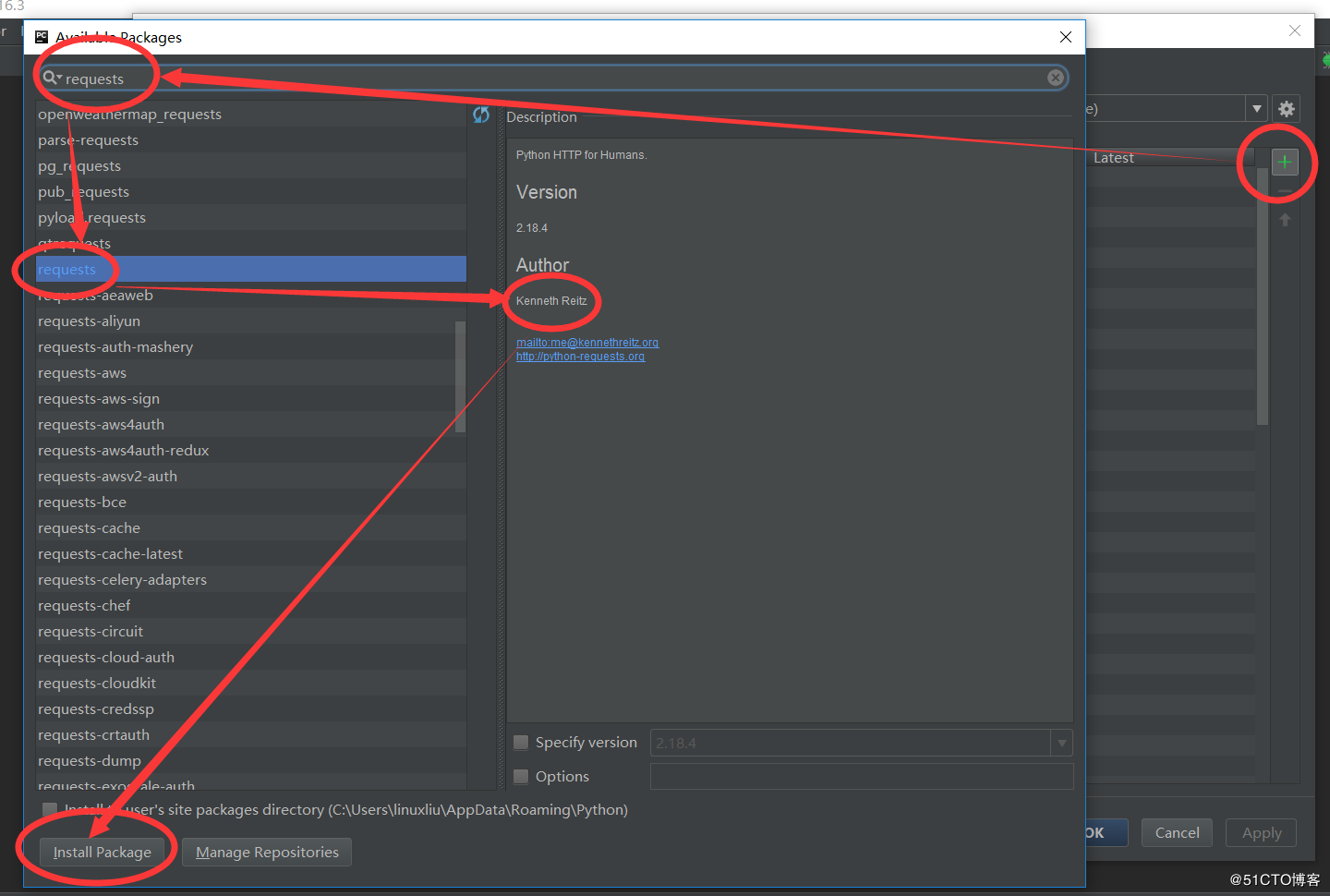| 运维学python之爬虫工具篇(一)Requests库的用法 | 您所在的位置:网站首页 › python requests get proxies › 运维学python之爬虫工具篇(一)Requests库的用法 |
运维学python之爬虫工具篇(一)Requests库的用法
|
历史:
运维学Python之爬虫基础篇(一)开篇:http://www.tiejiang.org/20403.html 运维学Python之爬虫基础篇(二)Urllib模块使用:http://www.tiejiang.org/20404.html 运维学Python之爬虫基础篇(三)Urllib模块高级用法:http://www.tiejiang.org/20405.html 运维学python之爬虫基础篇(四)Cookie:http://www.tiejiang.org/20418.html 运维学python之爬虫基础篇(五)正则表达式:http://www.tiejiang.org/20426.html 运维学python之爬虫实战篇(一)爬取百度贴吧:http://www.tiejiang.org/20450.html 运维学python之爬虫实战篇(二)爬取伯乐在线面向对象图片:http://www.tiejiang.org/20458.html
前面写都是基于urllib库来写的,今天开始了解python爬虫常用的工具库,今天介绍第一个库Requests中文官网 1 安装 1.1 直接安装要安装 Requests,只要在你的终端中运行这个简单命令即可: $ pip install requests 1.2 pycharm安装方法如果使用的是pycharm,安装方法见下图(顺序为按照箭头的方向操作):
如果安装完成,导入模块验证一下是否成功即可: >> import requests >>> 2 快速上手 2.1 发送请求使用 Requests 发送网络请求非常简单。 我们从导入 Requests 模块开始: >>> import requests 获取某个网页: >> import requests >> r = requests.get('https://www.baidu.com') >> print(type(r)) > print(r.status_code) 200 >> print(r.encoding) ISO-8859-1 >>> print(r.cookies) 为Response对象。我们可以从这个对象中获取所有我们想要的信息 Requests 简便的 API 意味着所有 HTTP 请求类型都是简便。例如: >> r = requests.post("http://httpbin.org/post") >> r = requests.put("http://httpbin.org/put") >> r = requests.delete("http://httpbin.org/delete") >> r = requests.head("http://httpbin.org/get") >>> r = requests.options("http://httpbin.org/get") 2.2 传递url参数你也许经常想为 URL 的查询字符串(query string)传递某种数据。如果你是手工构建 URL,那么数据会以键/值对的形式置于 URL 中,跟在一个问号的后面。例如, httpbin.org/get?key=val。 Requests 允许你使用 params 关键字参数,以一个字符串字典来提供这些参数。 例如:如果你想传递 key1=value1 和 key2=value2 到 httpbin.org/get ,那么你可以使用如下代码: >> payload = {'key1': 'value1', 'key2': 'value2'} >>> r = requests.get("http://httpbin.org/get", params=payload) 通过打印输出该 URL,你能看到 URL 已被正确编码: >> print(r.url) http://httpbin.org/get?key2=value2&key1=value1 注意字典里值为 None 的键都不会被添加到 URL 的查询字符串里。 你还可以将一个列表作为值传入: >> payload = {'key1': 'value1', 'key2': ['value2', 'value3']} >> r = requests.get('http://httpbin.org/get', params=payload) >> print(r.url) http://httpbin.org/get?key1=value1&key2=value2&key2=value3 2.3 响应读取服务器响应的内容 >> import requests >> r = requests.get('https://github.com/timeline.json') >> r.text u'[{"repository":{"open_issues":0,"url":"https://github.com/... Requests 会自动解码来自服务器的内容。大多数 unicode 字符集都能被无缝地解码。 读取json响应的内容: >>r = requests.get('https://api.github.com/events') >>r.json() [{'id': '7018640501', 'type': 'CommitCommentEvent', 'actor': {'id': 758844, 'login': 'glynhudson', 'display_login': 'glynhudson', 'gravatar_id': '', 'url': 'https://api... 读取原始的响应内容: 你想获取来自服务器的原始响应,你可以访问 r.raw。 初始请求中设置了 stream=True。 >> r = requests.get('https://github.com/timeline.json', stream=True) >> r.raw >> r.raw.read(10) '\x1f\x8b\x08\x00\x00\x00\x00\x00\x00\x03' 2.4 定制请求头如果你想为请求添加 HTTP 头部,只要简单地传递一个 dict 给 headers 参数就可以了。 >> url = 'https://api.github.com/some/endpoint' >> headers = {'user-agent': 'my-app/0.0.1'} >>> r = requests.get(url, headers=headers) 2.5 POST请求要实现发送表单形式的数据,只需简单地传递一个字典给 data 参数。你的数据字典在发出请求时会自动编码为表单形式: > playload = {'key1': 'value1', 'key2': 'value2'} >> r = requests.post('http://httpbin.org/post', data=playload) >> print(r.text) { "args": {}, "data": "", "files": {}, "form": { "key1": "value1", "key2": "value2" }, "headers": { "Accept": "*/*", "Accept-Encoding": "gzip, deflate", "Connection": "close", "Content-Length": "23", "Content-Type": "application/x-www-form-urlencoded", "Host": "httpbin.org", "User-Agent": "python-requests/2.18.4" }, "json": null, "origin": "115.171.69.64", "url": "http://httpbin.org/post" }
>> 你还可以为 data 参数传入一个元组列表。在表单中多个元素使用同一 key 的时候,这种方式尤其有效: >> payload = (('key1', 'value1'), ('key1', 'value2')) >> r = requests.post('http://httpbin.org/post', data=payload) >> print(r.text) { "args": {}, "data": "", "files": {}, "form": { "key1": [ "value1", "value2" ] }, "headers": { "Accept": "*/*", "Accept-Encoding": "gzip, deflate", "Connection": "close", "Content-Length": "23", "Content-Type": "application/x-www-form-urlencoded", "Host": "httpbin.org", "User-Agent": "python-requests/2.18.4" }, "json": null, "origin": "115.171.69.64", "url": "http://httpbin.org/post" }
>> 很多时候你想要发送的数据并非编码为表单形式的。如果你传递一个 string 而不是一个 dict,那么数据会被直接发布出去。 >> import json >> import requests >> url = 'http://httpbin.org/post' >> payload = {'some': 'data'} >> r = requests.post(url, data=json.dumps(payload)) >> print(r.text) { "args": {}, "data": "{\"some\": \"data\"}", "files": {}, "form": {}, "headers": { "Accept": "*/*", "Accept-Encoding": "gzip, deflate", "Connection": "close", "Content-Length": "16", "Host": "httpbin.org", "User-Agent": "python-requests/2.18.4" }, "json": { "some": "data" }, "origin": "115.171.69.64", "url": "http://httpbin.org/post" }
>> 此处除了可以自行对 dict 进行编码,你还可以使用 json 参数直接传递,然后它就会被自动编码。这是 2.4.2 版的新加功能: >> r = requests.post(url, json=payload) >> print(r.text) { "args": {}, "data": "{\"some\": \"data\"}", "files": {}, "form": {}, "headers": { "Accept": "*/*", "Accept-Encoding": "gzip, deflate", "Connection": "close", "Content-Length": "16", "Content-Type": "application/json", "Host": "httpbin.org", "User-Agent": "python-requests/2.18.4" }, "json": { "some": "data" }, "origin": "115.171.69.64", "url": "http://httpbin.org/post" }
>> 2.6 上传文件Requests 使得上传文件变得很简单: >> url = 'http://httpbin.org/post' >> files = {'file': open('report.xls', 'rb')} >> r = requests.post(url, files=files) >> r.text { ... "files": { "file": "" }, ... } 2.7 cookie如果某个响应中包含一些 cookie,你可以快速访问它们: >> url = 'http://example.com/some/cookie/setting/url' >> r = requests.get(url) >> r.cookies['example_cookie_name'] 'example_cookie_value' 要想发送你的cookies到服务器,可以使用 cookies 参数: >> url = 'http://httpbin.org/cookies' >> cookies = dict(cookies_are='working') >> r = requests.get(url, cookies=cookies) >> r.text '{"cookies": {"cookies_are": "working"}}' 2.8 超时你可以告诉 requests 在经过以 timeout 参数设定的秒数时间之后停止等待响应。基本上所有的生产代码都应该使用这一参数。如果不使用,你的程序可能会永远失去响应: >> >>> requests.get('http://github.com', timeout=0.001) Traceback (most recent call last): File "", line 1, in requests.exceptions.Timeout: HTTPConnectionPool(host='github.com', port=80): Request timed out. (timeout=0.001)
注意: timeout 仅对连接过程有效,与响应体的下载无关。 timeout 并不是整个下载响应的时间限制,而是如果服务器在 timeout 秒内没有应答,将会引发一个异常(更精确地说,是在 timeout 秒内没有从基础套接字上接收到任何字节的数据时) 3 高级用法 3.1 会话对象会话对象让你能够跨请求保持某些参数。它也会在同一个 Session 实例发出的所有请求之间保持 cookie,因为如果没有使用会话对象,每一次请求都相当于新的请求,类似于不同浏览器单独打开请求,如下面的请求: >> import requests >> requests.get('http://httpbin.org/cookies/set/sessioncookie/123456') >> r = requests.get('http://httpbin.org/cookies') >> print(r.text) { "cookies": {} } 使用会话对象后,创建对象实例s = requests.Session(),通过s去请求,结果如下: >> s = requests.Session() >> s.get('http://httpbin.org/cookies/set/sessioncookie/123456') >> r = s.get('http://httpbin.org/cookies') >> print(r.text) { "cookies": { "sessioncookie": "123456" } }
>> 3.2 SSL 证书验证Requests 可以为 HTTPS 请求验证 SSL 证书,就像 web 浏览器一样。SSL 验证默认是开启的,如果证书验证失败,Requests 会抛出 SSLError: requests.get('https://www.12306.cn') requests.exceptions.SSLError: HTTPSConnectionPool(host='www.12306.cn', port=443): Max retries exceeded with url: / (Caused by SSLError(SSLError("bad handshake: Error([('SSL routines', 'tls_process_server_certificate', 'certificate verify failed')],)",),)) github设置了,所以返回结果正常 requests.get('https://github.com') 3.3 流式上传Requests支持流式上传,这允许你发送大的数据流或文件而无需先把它们读入内存。要使用流式上传,仅需为你的请求体提供一个类文件对象即可: with open('massive-body') as f: requests.post('http://some.url/streamed', data=f) 注意: 建议你用二进制模式(binary mode)打开文件。这是因为 requests 可能会为你提供 header 中的 Content-Length,在这种情况下该值会被设为文件的字节数。如果你用文本模式打开文件,就可能碰到错误。 3.4 代理如果需要使用代理,你可以通过 proxies 参数来配置单个请求: import requests
proxies = { "http": "http://10.10.1.10:3128", "https": "http://10.10.1.10:1080", }
requests.get("http://example.org", proxies=proxies) 你也可以通过环境变量 HTTP_PROXY 和 HTTPS_PROXY 来配置代理。 $ export HTTP_PROXY="http://10.10.1.10:3128" $ export HTTPS_PROXY="http://10.10.1.10:1080"
$ python >> import requests >>> requests.get("http://example.org") 具体更多的功能,可以参考文档进一步研究。 |
【本文地址】

